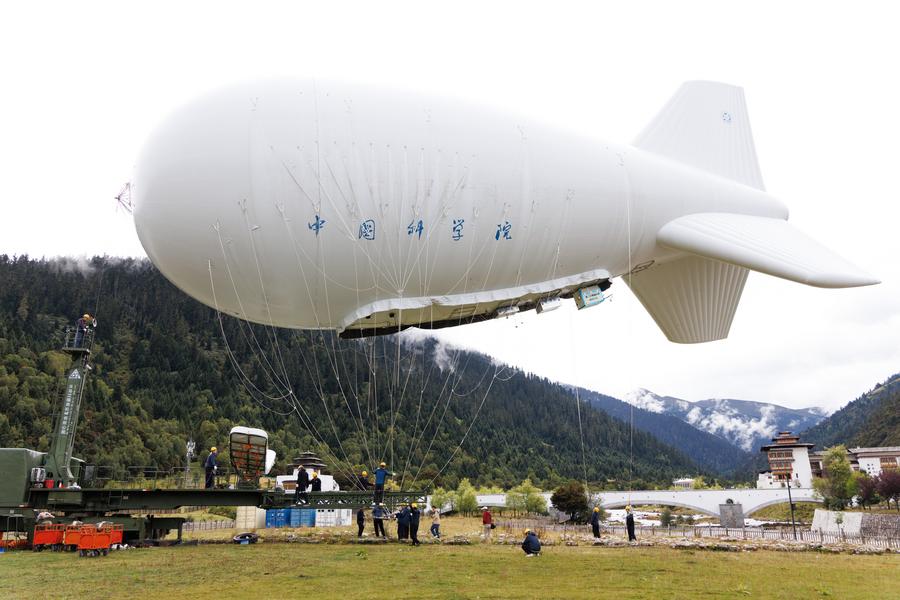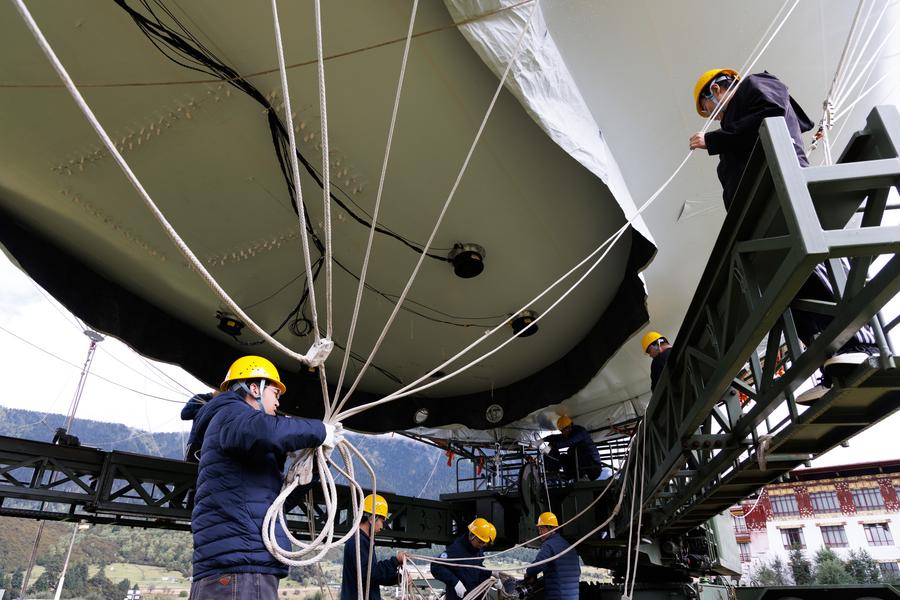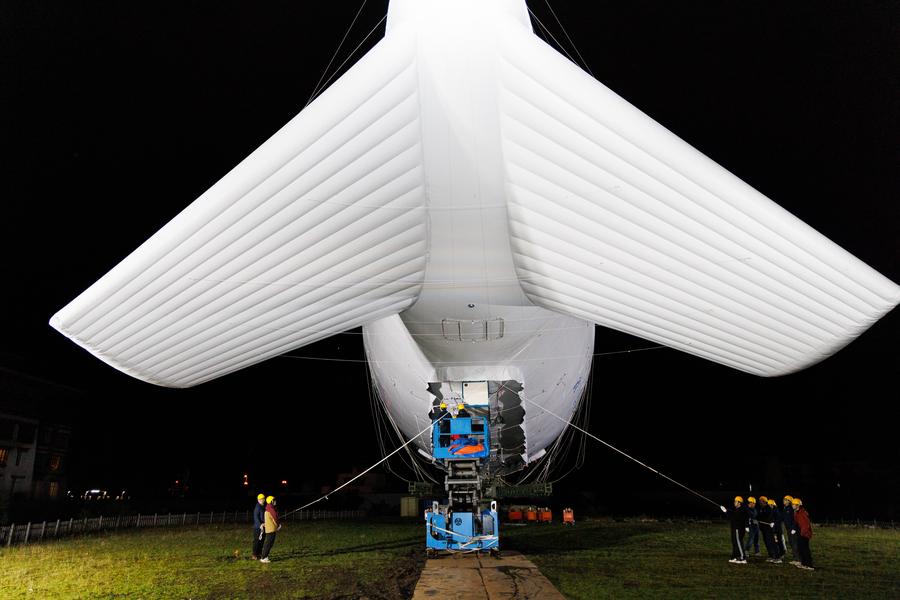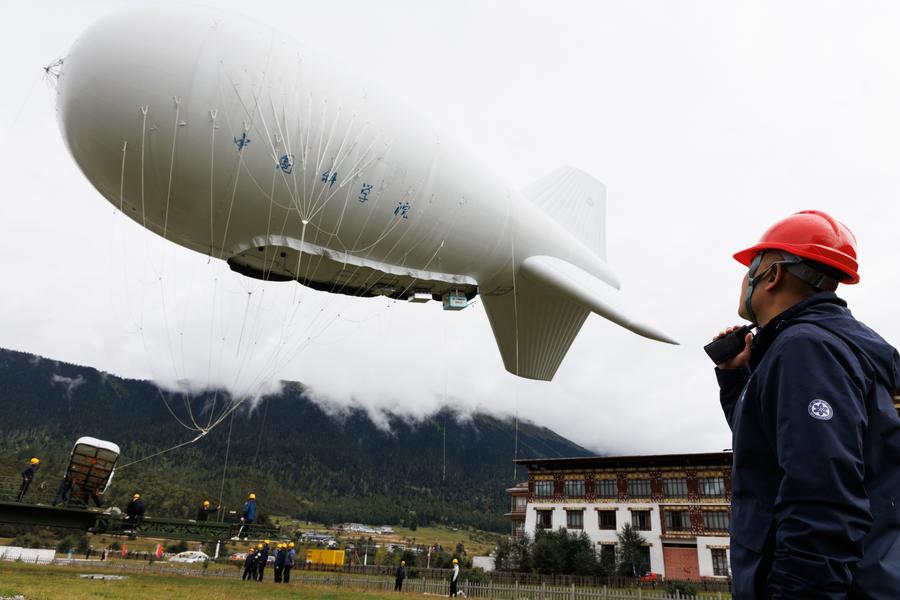

"Jimu-1" tethered balloon hovers above the ground in Lulang, Nyingchi, southwest China's Xizang Autonomous Region, Sept. 18, 2025. (Xinhua/Jin Liwang)
Chinese scientists recently carried out the "Jimu-1" tethered balloon atmospheric observation experiment in Lulang, Nyingchi, southwest China's Xizang Autonomous Region, which is expected to provide a new perspective for unraveling the mysteries of the Qinghai-Tibet Plateau ecosystem.
The tethered balloon was equipped with 16 types of scientific payloads with a total weight of approximately 200 kilograms. It successfully ascended to an altitude of 5,500 meters. Through coordinated multi-payload observations, the experiment achieved a technological leap from single-point sampling to three-dimensional monitoring, according to the Aerospace Information Research Institute (AIR) of the Chinese Academy of Sciences, the major developer of the tethered balloon.
The experiment accurately obtained key data on atmospheric composition, pollutant distribution and three-dimensional cloud microphysics. These data will underpin China's second Qinghai-Tibet Plateau scientific expedition and help decipher the region's climatic and environmental changes, said Zhang Taihua, a senior engineer at AIR.
Aerostats -- aircraft that rely on a lifting gas less dense than air (usually helium) -- predate airplanes. Among them, tethered balloons offer long endurance, wide coverage, flexible deployment, strong payload capacity and low operating costs, making them core platforms for integrated "air-space-ground" observation systems.
With its towering altitudes and vast glaciers, the Qinghai-Tibet Plateau serves as a major reservoir of water, earning it the title "Asian Water Tower." As a region highly sensitive to global climate change, its environmental monitoring is vital for regional sustainable development.

Technicians control auxiliary tethers during the "Jimu-1" tethered balloon atmospheric observation experiment in Lulang, Nyingchi, southwest China's Xizang Autonomous Region, Sept. 18, 2025. (Xinhua/Jin Liwang)
The "Jimu-1" tethered balloon boasts core strengths, including heavy payload capacity, ultra-long endurance, powerful interference resistance, and high adaptability to complex environments, enabling it to execute observation missions reliably under harsh operating conditions, Zhang said.
In the present experiment, conducted in the challenging plateau environment, the tethered balloon overcame a succession of severe constraints. It had to contend with localized, rapidly developing severe convective weather, evade destabilizing turbulent airflows, and withstand sub-zero temperatures at high altitudes. As of Sept. 19, the tethered balloon had completed 30 flights, spanning multiple altitude layers and meteorological scenarios.

Technicians adjust the observation payloads during the "Jimu-1" tethered balloon atmospheric observation experiment in Lulang, Nyingchi, southwest China's Xizang Autonomous Region, Sept. 18, 2025. (Xinhua/Jin Liwang)
Since 2017, tethered balloons have been deployed in China's second scientific expedition to the Qinghai-Tibet Plateau. In 2022, the "Jimu-1" ascended to 9,050 meters, surpassing the height of Mount Qomolangma and setting a world record for observation altitude by a tethered balloon of its kind. Equipped with meteorological, environmental and geological payloads, it has gathered vast amounts of high-quality data, supporting key national research and scientific breakthroughs on the plateau.
The extreme cold, strong winds and low barometric pressure of the plateau posed challenges to the early-generation tethered balloon equipment. The team has continuously optimized key technologies, including tethered balloon design, structural strength, pressure control and power supply, according to He Zeqing, deputy director of the aerostat system research and development center of AIR.

"Jimu-1" tethered balloon ascends in Lulang, Nyingchi, southwest China's Xizang Autonomous Region, Sept. 18, 2025. (Xinhua/Jin Liwang)
AIR's tethered balloon family has evolved from a single model into a full spectrum spanning light, medium, large and heavy-lift classes.
These tethered balloons now serve scientific observations, emergency communications, grassland ecology, maritime relay communications, Earth observation and security monitoring, said Cai Rong, a researcher at AIR.
In north China's Hulunbuir grasslands, for instance, the tethered balloon team combined high-resolution spectral imaging with AI to monitor pasture growth and degradation while also tracking livestock numbers and distribution, offering scientific guidance for ecological protection and sustainable animal husbandry.
In the field of ocean monitoring and communications, the team developed China's first ship-based tethered balloon system and completed multiple trial demonstrations in Chinese waters, solving the long-standing problem of poor communication coverage in remote sea areas and lending key technological support to the country's smart-ocean initiative. (Xinhua)

86-10-68597521 (day)
86-10-68597289 (night)

52 Sanlihe Rd., Xicheng District,
Beijing, China (100864)

